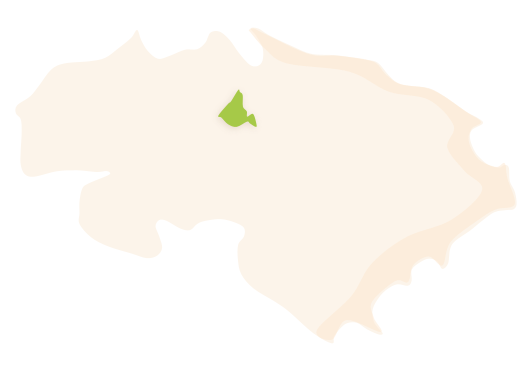Sagra is a municipality belonging to the central subregion known as La Rectoria (together with Tormos, El Ràfol d’Almúnia, Benimeli and Sanet i Els Negrals) nestled within the middle course area of the River Girona, at the western foot of Segària. The village is situated at an altitude of 104 metres above sea level, with an area of 5.6 km² and 427 inhabitants, who are known locally as Sagratins and Sagratines.
 Sagra's municipal district. Surface area: 5.6 km². Population: 427 (INE data 2021).
Sagra's municipal district. Surface area: 5.6 km². Population: 427 (INE data 2021).HISTORY
Sagra is located at the foot of the Cabal and Recingles mountains. It is a small village with very few inhabitants that manages to attract the curiosity of those who visit it. Sagra’s natural surroundings are typical of the area, seducing anyone who goes hiking along its paths.
Its origins go back to an old Islamic farmstead, as indicated by the name. According to Coromines, the etymology derives from the Arabic sahra, which means 'cliff' (and which would have become sa(k)ra/sa(g)ra due to the Moorish pronunciation), as a clear geographical reference to the end cliff of the Segària mountain range that watches over the settlement.
The farmhouse already appeared as Saçra in Jaume I’s “Llibre de Repartiment”. After the Christian conquest it belonged to Juan Pérez de Cuyllera, but during the first half of the 13th century it was bought by Eximén Pérez de Tarazona and confirmed by the King in 1249.
It should be noted that on November 14th, 1279, King Pere III granted these lands by charter to the “Sarrecenos Moros”, establishing that Muslims could inherit their lands with their own customs and that they could also have their own judges or “alamins”, according to their traditions. The charter also allowed the Muslim population to continue with their prayers in the mosques and stated that they could never be captured as slaves.
The farmstead and the control of the land passed from hand to hand. In 1286, it belonged to Pedro Jiménez de Ayerbe and some years later, in 1299, Raimundo Vilanova obtained it by way of a donation. Finally, on September 17th, 1341, it was acquired by the Order of Santiago, together with Sanet i Els Negrals, thanks to a royal order issued by Pere IV El Ceremoniós.
It was a Moorish settlement that had 50 hearths in 1609 and so, after the expulsion decree, Sagra became an abandoned village. It was repopulated with people from Catalonia and Majorca, according to the definitive settlement charter granted on March 5th, 1613 (previously, there had been two failed attempts on February 7th, 1610, and February 7th, 1611). During that century, the parochial centre of La Rectoria was located in Sagra, due to the fact that it had the most number of Old Christians.
Currently, some of the most common surnames are Ballester, Estela, Femenia and Ferragut.
FESTIVITIES
- The festivities of Saint Antoni Abat are celebrated on the 17th of January.
- The patronal festivities are celebrated from the 8th to the 13th of August, in honour of the patron saints Abdó and Senent, and La Puríssima and Santíssim Crist del Consol.
GASTRONOMY
- Soupy rice with beans and cardoons.
- Vegetable dumplings.
- The traditional meat and vegetable stew with wheat known as “blat picat”.